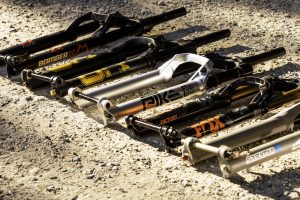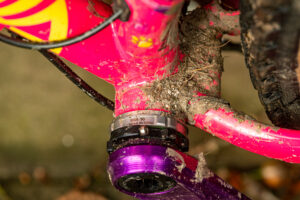Rear suspension amplifies the fun off-road. Here's our pick of the best XC, trail, and enduro full-suspension mountain bikes.
Choosing the right full-suspension bike can be a complex and nerve-wracking process, with a mind-boggling array of options on the market. We have tested all of the following bikes. Tested them properly against their peers, backed up with years of experience reviewing thousands of mountain bikes since MBR was launched back in 1997. This isn’t some shortlist pulled together from browsing brochures and brand websites – these are the best mountain bikes, ridden and rated by some of the most experienced testers in the business, all with a shared passion for mountain biking and giving you the best buying advice possible.

The Polygon Siskiu T8 is a slick full-sus trail bike with a down-to-earth price tag.
1. Polygon Siskiu T8
Best value full-suspension bike
Wheel size: 27.5in or 29in | Frame sizes: S, M, L, XL | Weight: 15.6kg | Suspension travel: 150mm f/140mm r 27.5in, 140mm f/135mm r 29in | Rating: 9/10
Reasons to buy:
- Progressive sizing and geometry
- Great value for money
Reasons to avoid:
- Needs a Shimano chain
If you’re on a tight budget, there are few better full-suspension options on the market than the Polygon Siskiu T8. There are two versions to choose from, one with larger, faster rolling 29in wheels but less suspension travel, and one with more agile 27.5in wheels and slightly more bounce at both ends. In both cases, you get a quality alloy frame with fully adjustable Fox suspension.
Whichever wheel size you choose, you’ll be rewarded with pace and handling that matches bikes with much more serious hang tags. The chain is pretty much the only weak link in the specification, so you can ride the Siskiu hard straight from the showroom floor.
Read the full review of the Polygon Siskiu T8

The Cannondale Habit 4 boasts direct-sales value, but you can buy it from a physical store.
2. Cannondale Habit
Most fun trail bike for under £2k
Wheel size: 29in (XS frame gets 27.5in wheels) | Frame sizes: XS, S, M, L, XL | Weight: 15.2kg | Suspension travel: 140mm f/130mm r | Rating: 9/10
Reasons to buy:
- Agile and easy to ride, the Habit 4 handles like a much more expensive machine
- Shock tune feels perfect
- Fun and flicky ride that keeps rider weight well-balanced on all trail gradients
- SRAM DB8 brakes feel solid and have a smooth action for a budget brake
Reasons to avoid:
- RockShox’s Recon RL fork lacks finesse and precise tuning
- Deore drivetrain shifts can be slightly clunky, especially with the KMC chain
- Maxxis Rekon tyres use harder compound with less wet weather grip
Cannondale has done a stellar job with the new Habit trail bike. Coming in at under £2k for the entry-level model is impressive given that you can buy it from a bricks-and-mortar store, and yet it still comes with decent tyres, quality suspension, and a dropper post. It’s a good looking bike, with a slick alloy frame that is worth upgrading over time.
The handling is quick and snappy, making it fun and rewarding to throw around, and the suspension is smooth and supple, bringing both comfort and agility to the party. To sum up, as we said in the review, “as a pure trail bike, it nails the fundamentals of geometry, suspension and efficiency and has an engaging, responsive ride quality that feels anything but budget”.
Read the full review of the Cannondale Habit 4

Specialized’s classic four-bar suspension delivers on its promise of 160mm travel
3. Specialized Status
Best budget mixed wheel play bike
Wheel size: 29in f/27.5in r | Frame sizes: S1, S2, S3, S4, S5 | Weight: 15.75kg | Suspension travel: 160mm f/160mm r | Rating: 10/10
Reasons to buy:
- Killer value for money
- Inspiring handling
- Wide range of sizes
Reasons to avoid:
- Sluggish NX shifting
- Lack of official product info is frustrating
If you’re starting to see a few grey hairs appear then you may well remember the iconic Specialized Big Hit. Although not the original mullet bike, it was perhaps the most successful mixed wheeler before the trend’s recent resurgence. Why was it such a big hit, if you’ll excuse the pun? Well, it wasn’t designed for long distances or going racing, it was built to put a smile on riders’ faces. And it succeeded in spades. The Status invokes the spirit of that classic Big Hit, with a mixed wheel set-up, an affordable price, and the ability to generate fun at every turn. Now there are two models on offer, one with 140mm travel, and the original version with 160mm travel. Whichever one you pick, you’re in for a great time.
Read our full review of the Specialized Status 160

The Specialized Stumpjumper Evo is our favourite trail bike
4. Specialized Stumpjumper Evo
The ultimate adjustable trail bike!
Wheel size: 29in | Frame sizes: S1, S2, S3, S4, S5, S6 | Weight: 14.6kg | Suspension travel: 160mm f/150mm r | Rating: 10/10
Reasons to buy:
- A truly versatile trail bike with addictive handling
- Adjustable geometry and internal frame storage
Reasons to avoid:
- Uses a smaller 30t chainring, so you can run out of gears on descents
Our Trail Bike of the Year for 2022, and the recent winner of our adjustable trail bike test, the Specialized Stumpjumper Evo effortlessly blends pleasure and performance and boasts the ultimate adjustability of any trail bike. That means head angle, BB and chainstay adjustment, to give a whopping 6 different configurations.
Choose from alloy or carbon frames according to your budget, while the comprehensive range of sizes means everyone can enjoy the perfect fit. Part enduro shredder, part trail ripper, the Stumpjumper Evo makes every ride better and even boasts internal storage for stashing your snacks.
Read our full review of the Specialized Stumpjumper Evo Comp
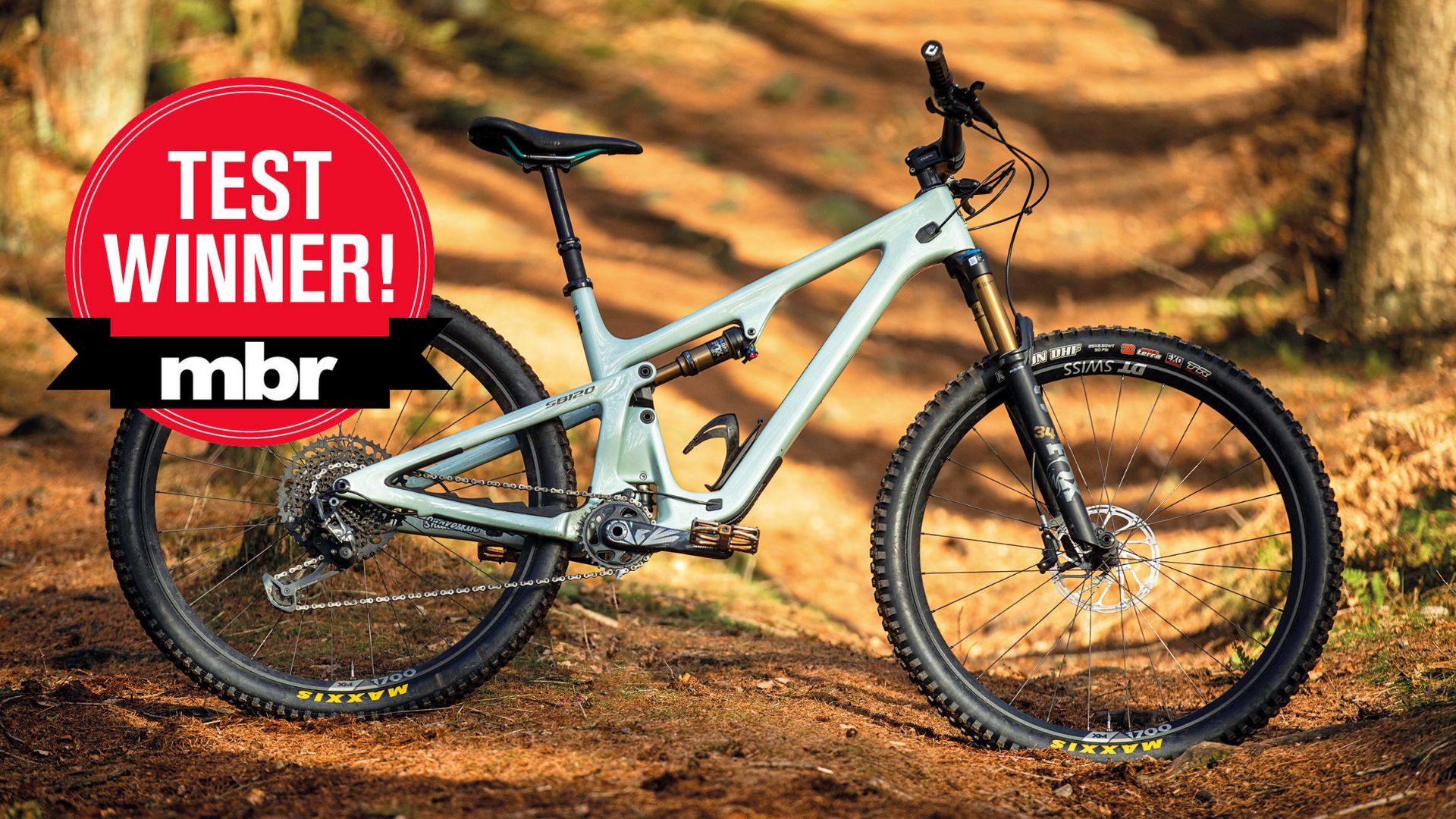
5. Yeti SB120
Best short travel down-country ripper
Wheel size: 29in | Frame: Turq carbon, 120mm | Weight: 13.3kg (29.3lb) | Rating: 9/10
Reasons to buy:
- All round overachiever with superlative suspension
Reasons to avoid:
- Agile rather than ultra aggressive
Yeti’s SB120 had us in rapture when we tested it against the Santa Cruz Tallboy. Eye-wateringly rapid, yet forgiving and comfortable at the same time, the SB120 isn’t afraid of showing its softer side.
The suspension offers bags of grip while responding instantly to pedal inputs. A touch of frame flex means it sticks to lines rather than getting pinged from side to side, making it more suitable for natural terrain than sculpted bike park trails. With a head badge that evokes passion in any serious mountain biker, the Yeti SB120 is a bike you can’t help looking back over your shoulder at when you walk away from the garage.
Read our full review of the Yeti SB120

6. Santa Cruz Tallboy
A two-wheel terrier: The down-country bike that thinks its an enduro bike
Wheel size: 29in | Frame: Carbon CC, 120mm | Weight: 13.08kg (28.84lb) | Rating: 9/10
Reasons to buy:
- Outstandingly fast and focused full-send aggression
Reasons to avoid:
- Needs a pretty skilled rider to avoid prat-falls
- Uncomfortably uncooperative on technical off-piste trails
Santa Cruz seems to have a gazillion models that all look the same, so it’s easy to miss the diminutive Tallboy. With only 120mm of travel, there’s no safety blanket to fall back on, but for skilled riders, that connection to the trail is addictive. There are 29in wheels front and rear, and a choice of two different carbon frames depending on your budget.
When we tested the Tallboy we said: “The bristling in-your-face aggression of the brutally stiff frame, ‘fast or F-off’ suspension and progressive geometry creates a whole new level of ‘short-travel bike syndrome’ that hard-charging hooligans will love”. It’s not as forgiving as the Yeti SB120, but it’s fabulously rewarding.
Read our full review of the Santa Cruz Tallboy

7. Transition Spur X01
Best down-country bike for effortless speed
Wheel size: 29in | Frame sizes: S, M, L, XL | Weight: 11.25kg | Suspension travel: 120mm f/120mm r | Rating: 10/10
Reasons to buy:
- Perfect speed/capability ratio
- Super light
- Looks amazing
Reasons to avoid:
- Business-like way it keeps wheels on the ground
Did someone say down-country? The Spur is the original and, we’d argue, still the best. Why? Well it blends trail bike capability with XC bike pace, feeling impossibly fast everywhere, while goading you into pushing your limits on every descent.
Avoid the temptation to overfork the front end. Instead, keep a SID up front for maximum weight saving, and stick with light wheels and rapid tyres. Keep the build svelte, and you’ll revel in the effortless speed and endless momentum. Like mountain biking experienced x1.5 speed.
Read our full review of the Transition Spur

Did the Mondraker Raze RR impress us? Yes, it did.
8. Mondraker Raze
Next level performance with integrated data logging
Wheel size: 29in | Frame sizes: S, M, L, XL | Weight: 13.65kg (30.09lb) | Suspension travel: 150mm f/130mm r | Rating: 10/10
Reasons to buy:
- Fast and capable
- Built-in suspension data acquisition
- Excellent on-trail performance
Reasons to avoid:
- You need a 4G connection to keep the MIND engaged
With Forward Geometry, Mondraker revolutionised how we think about mountain bike sizing. Ten years on and the Spanish brand is revolutionising suspension set-up. With MIND, Mondraker’s built-in suspension data acquisition, suspension set-up and analysis has never been easier or more accurate. On its own, the Raze RR is a great package, with MIND it offers next level technology and performance for a small up-charge. More importantly, Mondraker has nailed the balance of speed, compliance and capability with the Raze RR to perfectly capture the essence of the short-travel trail category.
Read our full review of the Mondraker Raze Carbon RR

Integrated suspension system conceals the RockShox NUDE 5 shock inside the full carbon frame
9. Scott Spark RC WC AXS
Best XC race bike
Wheel size: 29in | Frame sizes: S, M, L, XL | Weight: 11.12kg | Suspension travel: 120mm f/120mm r | Rating: 9/10
Reasons to buy:
- Ruthless in its efficiency
- Hidden shock should need less maintenance
- TwinLoc remote suspension control is a big advantage
Reasons to avoid:
- Suspension could be more supple in Descend mode.
Scott’s Spark has won more trophies than any other race bike, with double Olympic gold back in 2016. The current model gets a sleek carbon frame with modern geometry, so it’s fast, but also surprisingly capable on the descents, so it’s impressively versatile. It also gets a hidden shock for reduced maintenance, and remote suspension control for uphill efficiency without compromising on downhill confidence.
Read our full review of the Scott Spark RC WC AXS
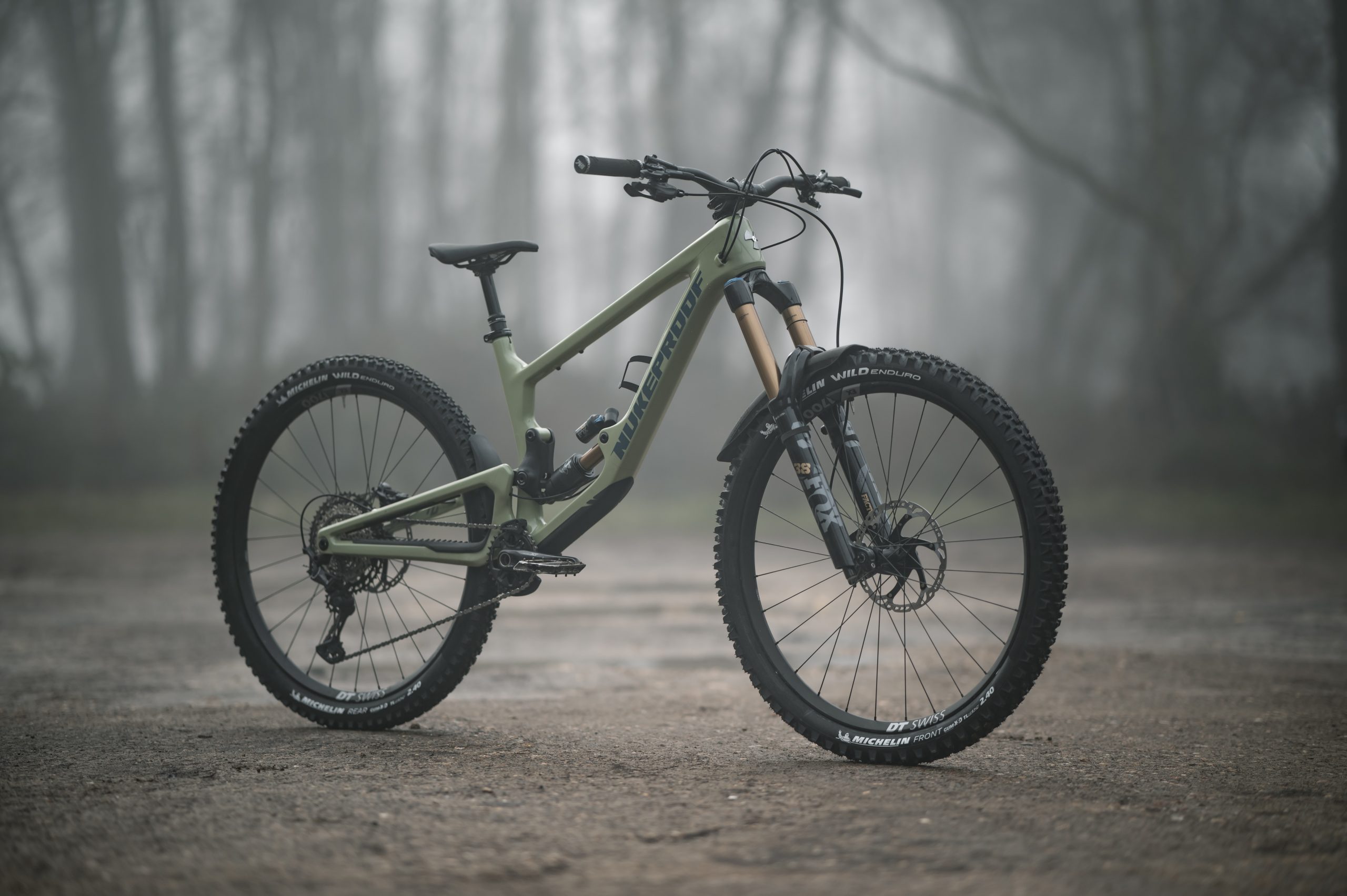
10. Nukeproof Giga
Best long-travel enduro bike
Wheel size: 27.5, 29in or mullet | Frame sizes: S, M, L, XL, XXL | Weight: 15.4kg | Suspension travel: 180mm f/170mm r | Rating: 10/10
Reasons to buy:
- All of the travel, none of the drawbacks
- Surprisingly agile and dynamic
Reasons to avoid:
- Michelin tyres are slow and temperature sensitive
- Uncertain future for the brand could be an issue if something goes wrong
The Giga is testament to the adage that you can have your pudding and eat it. You can all of the all-ness all of the time. Loads of travel. Slack AF head angle. The biggest of wheel sizes. And the most remarkable thing? It rides just like a normal mountain bike when the gradient tips up. The Giga really is a race-worthy enduro bike that doesn’t feel like a chore to pedal around on your Sunday Social rides. Poppy and playful, the Giga is no passive plough.
With the brand’s future in doubt, there’s no guarantee that any warranty issues will be sorted, so bear that in mind before buying.
Read our full review of the Nukeproof Giga 290 Carbon Factory
Hardtail or full-suspension?
It’s easy to assume that everyone would be riding full suspension bikes instead of hardtails if there was no price difference. This isn’t really true. Hardtails do have some advantages over full-suspension bikes regardless of price tag.
Hardtails are lighter. Hardtails have less to go wrong or require servicing. Hardtails are easier to clean. Hardtails can be faster and more fun on smoother trails. Adding to this the fact that hardtails are cheaper than their full-sus counterparts means that hardtails aren’t going to be extinct anytime soon.
What are the benefits of going full-suspension? First and foremost, control. Full suspension bikes track the ground better and as such offer greater traction. Full-suspension bikes are more composed and not as sketchy to ride as hardtails. The fatigue and comfort benefits are also important, particularly over longer distances. Being less beaten up and less tired on longer rides is an added bonus of bounce.
What are the drawbacks of full-suspension? They’re heavier than hardtails. They usually have a lower component spec (compared to hardtail of the same price). They have bearings and pivots that will eventually wear out and cost money to replace/service. They can be mud traps. They can be difficult to clean properly. And if you don’t understand the basics of how to setup suspension, then a full-suspension bike can ride really badly, inefficiently and sketchily.
Carbon or aluminium?
At the mid to high end level there’s something of a crossover point where you can sometimes choose between a carbon framed bike (with lower end parts) or an aluminium framed bike (with better bits) at around the same price point. We’d always recommend going for the better specced aluminium model.
Is carbon worth the extra money? For most riders, no it isn’t. Just how much extra does it cost anyway? To go carbon will cost you approximately an extra £1,000 (for the similarly equipped bike).
What does this £1,000 get you? A lighter frame for sure. But not that much lighter, maybe 700g or so at the absolute most. The more convincing argument for going carbon is not weight, it’s ride feel. Carbon bikes ride differently to aluminium bikes. Stiffer. Sometimes with a damped (dead) sort of feeling. And these days carbon bikes are often stronger than their aluminium counterparts.
The carbon feel and strength is what it’s all about. This is not to say that this racy, rally-car ‘carbon feel’ is going to suit everyone. Some riders prefer the feel of aluminium bikes over carbon.

Which wheel size is best?
This old chestnut. Again, we’re going to be mildly controversial and say that the difference between 27.5in bikes and 29er bikes isn’t as pronounced as it was back in the mid ’00s.
Nowadays you can get 29ers with decent amount of suspension travel (up to 170mm – more for DH) and with decent geometry, so the wheel size debate has fizzled out. Some brands even offer two versions of each model, one with 27.5in wheels and one with 29in wheels, so you can just choose the option that suits you.
29ers are more stable and have better grip. But they have unavoidably higher front ends and the rear tyre can hit your bum on steep stuff if you’re under 6ft tall. The higher wheel axles can make the bike feel taller in tight switchbacks and thus require more leaning over. 27.5in bikes can be stiffer, can have lower front ends and the rear tyre won’t boot you up the behind on steep drops and chutes. The lower wheel axles require less body English in tight hairpins so the bikes can feel more nimble for a given rider input.
If you’re 6ft tall or over, you’re probably going to better served by a 29er. If you’re under 5ft 6in then a 29er is likely going to feel too big. Which is where the mullet bike, or MX, fits in. These models use a 29in wheel up front (for maximum stability, speed and rollover) paired with a 27.5in wheel at the back (to improve agility and bum clearance). They’re a great option for riders who want a fun, playful bike or have shorter legs.
Which suspension design is best?
A bonus debate for you. Sorry! Although there’s less hype and grand claims made about different suspension frame designs these days (compared to the slanging matches and OTT marketing of yore, anyway) there is still a valid interest in how the designs differ from each other. The mountain biking market is now mature and experienced enough to admit that there is no single Best Suspension Design. The four-bar (or Horst Link) used to be the Holy Grail. Single pivots used to get ragged on for being crude. Neither of these stances are correct.
To be frank, pretty much all suspension designs are good. But they are not all the same. They do differ in how they feel and respond (to both the trail and to the rider onboard). Some are fussy in how precisely they’re set up, some are more forgiving. Some also require more maintenance than others. The rear shock – and how you can tune it – is arguably more important than frame suspension design these days. It is now possible to do an awful to with a rear shock to alleviate any frame design niggles you may encounter. Bike too bob-prone, or wallowy, or harsh bottom out? Chances are something can be done with the rear shock to address this.
Basically, bike companies have got most of the kooky, bad designs out of their system now. The differences between them are now extremely subtle. Learning about suspension theory and setup is more important.
By gum it’s good to be back! We’ve waited long months and hunted down the best trail bikes to finally put together another annual edition of the UK’s ultimate trail bike test.
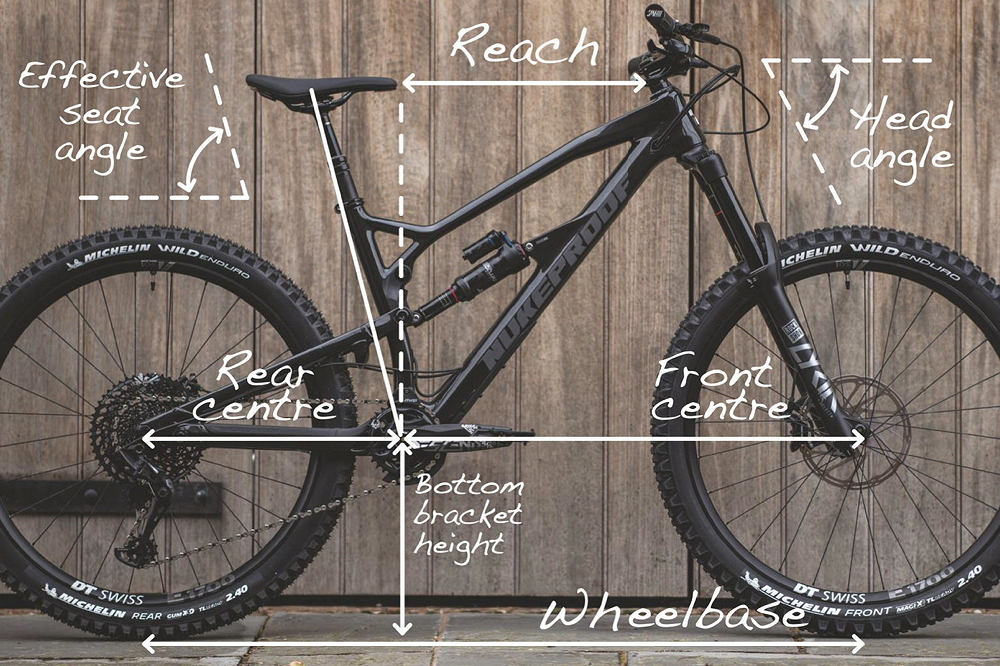
Geometry, geometry, geometry
The angles and lengths of the frame tubes governs almost everything in how a bike will ride. The best suspension in the world counts for nought if the geometry is poor. Similarly, a bike with great geometry can often overcome any suspension shortcomings and ride just fine.
What’s the best geometry for a mountain bike? This is a tricky area and one which is still full of old myths and prejudices. But here’s our take on it…
Long reach (the distance between saddle and handlebars, in layman’s terms) is good. Steep seat angles are good. Slack head angles are good. And we’re not talking just ‘good for descending’. This geometry is good everywhere. Slack head angles don’t cause front end wandering on climbs (that’s caused by slack seat angles and/or short top tubes).
Low bottom bracket heights are generally good (for stability and for cornering), but riders who pedal in rutted/tufty/stumpy terrain, or like to be challenged by rocky, trials-style terrain, may get bored with frequent pedal strikes and so prefer a higher bottom bracket height and accept the compromise in handling.
Chainstay length is another area full of cliché. Short chainstays are seen as highly desirable. Long chainstays are seen as bad. Why is short good? We’re not sure it is particularly. It makes bikes easier to manual but that’s about it. They can be problematic on climbs if the seat tube is too slack, making it difficult to keep the front wheel weighted. Long chainstays offer greater stability and climbing prowess, but there is a trade-off in agility.
Another aspect these days is the return of standover as being high on the important list. The advent of dropper posts with 150mm+ of travel has meant that bike designers are factoring shorter seat tube lengths in their bikes now so that they can fit in long drop dropper posts. Truth be told though, you still can’t judge how a bike will ride by looking at its geometry chart. Geometry is a combination of multiple factors that all interact with each other. One isolated measurement doesn’t govern everything.
How much should you spend?
If you have less than £1,000 to spend then we still think a hardtail is the way to go. Sub-£1k full-sussers are going to be overly hefty and sport low-end kit that will impair your ride experience.
These days you can get capable and fun full-suspension bikes for between £1,000 and £2,000. They aren’t especially light but they aren’t restrictively heavy either. And the parts package on a good £1k susser will feature perfectly good stuff from recognised brands. Sure there’ll be some cost-cutting here and there, and some no-name finishing kit, but it won’t overly affect the bike’s ride.

What size bike should you get?
A lot of people are riding around the wrong size bike.
The first myth to bust is that smaller bikes are more nimble/playful/manoeuvrable. Nope. Smaller bikes are less stable, more sketchy and uncomfortable. Don’t buy a bike that’s too small thinking it’ll be alright. Don’t get suckered into buying the wrong size bike because it’s at a bargain price. A cheap bike that’s big enough for you and has good geometry will be infinitely better than a half-price bling bike that’s too small for you.
The best way to do it is consult a size calculator (most bike brands have them), confer with other owners, and (if you’re in the 5ft 10in – 5ft 11in height range) check out our reviews. We always add the rider height and size tested information in the specification table and we will usually comment on the sizing within with review. You should also check out our guide to choosing your mountain bike frame size. Remember that there is a degree of adjustability when it comes to fit with any frame size – you can slide saddles fore and aft on the rails, you can run longer or shorter stems, high-rise or low-rise bars – but you can never change the length of the seat tube.







